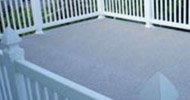Ledger lateral load system questions
by Zack
(PA)
I am building a deck and my township requires the use for a lateral load system. I guess you need to tie your deck through your foundation into your floor boards.
It uses a piece of 1/2" threaded rod and a couple of connectors to mount to. My issue is that all the drawings you find for this show the floorboards at the same level as the deck. My deck sits about 6" lower that my floor boards and i do not know what to do. Please let me know if you can help.
Editor's Comments:
The lateral load on ledger deck connections is a great question and one that has generated a lot of confusion among homeowners, builders and even building inspectors because of the indeterminate language used in the latest re-write of the code.
Permitted Misread as Required
It shows how lobby groups can effectively push legislators to draft code provisions around their proprietary product lines. In this case that language was cleverly written to say "shall be permitted" rather than saying nothing or providing language which would allow for any technique that can be shown to meet a minimum standard.
The end result of this is many inspectors often read this as meaning it is required when it is not. It even confuses architects and manufacturers as they draw plans and try to be helpful and inform consumers.
It turns out that a team of curious engineers at Washington State University have proved in very convincing fashion that the new lateral load connection systems that Simpson has been pushing to be written into the code (and now GRK has felt pressure to develop a competing alternative) are not necessary at all.
The testing was very thorough and has shown that the original recommended lag screw methods were able to resist a force four times greater than overloaded deck of people ever could.
Glenn Matthewson of NADRA summarizes this entire subject very succinctly.
You must watch this video:
Deck Lower Than Sill Of Floor
This is a big problem that has developed as people try to comply with this permitted but not required connection system.
You are quite right in that if you are using this kind of band board connection system the range of elevation change from the first floor to the decking is very low.
And yet most decks ought to be set up to a maximum of 7-1/2" down to simulate a step and minimize the risk of rain or snow penetrating the inside of the home. If you use this kind of system you can not easily achieve that.
Joists Not Perfectly Aligned
Another big inconvenience is when the joist in the house are not parallel with each of the joists in deck. In that situation it requires a lot of extra work to locate each joists location and try to add in extra joists in the deck to mate with them.
Further challenges arise then the joists in the home run perpendicular to the joists on the deck.
Bottom line here is without thinking things through, without any science or engineering evidence a code provision has been written that has now been shown as entirely unnecessary and adding huge costs and inconvenience to homeowners and builders.
To make matters more challenging the drafters decided to use ambiguous language such as "permitted" which is not commonly done in code documents for the very reason that code directives are intended to be as clear as possible.
If any builders out there have personal experience with this please leave your comments.


























